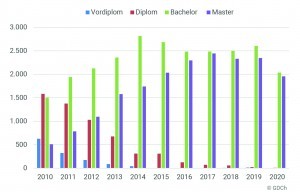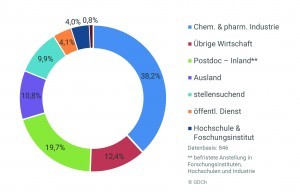The coronavirus pandemic did not have a noticeable impact on chemists entering the profession in 2020 compared to previous years. This is shown by the annual statistics for chemistry degree courses from the German Chemical Society (GDCh). The data on job-seeking and temporary graduates with a doctorate correspond to the stable figures of recent years. In general, slightly fewer first-year students (9384) opted for a chemistry degree course last year than in 2019 (9422). The number of students who completed a chemistry degree course also fell from 3905 in the previous year to 3363 in 2020, as did the number of doctorates. This fell from 2181 in 2019 to 2104 in the reporting year.
The results for the individual degree programs were as follows
- In chemistry/economic chemistry, the universities reported 5671 first-year students (2019: 5746). 2037 students (2019: 2605) successfully completed their Bachelor's degree, 1956 received their Master's degree (2019: 2348). The median duration of study was 6.9 semesters until the Bachelor's degree (2019: 6.7) and 5.0 semesters until the Master's degree (2019: 4.8). In 2020, 1838 people completed a doctorate in chemistry/economic chemistry (2019: 1921). The median duration of the doctorate was 8.2 semesters (2019: 8.3).
- In biochemistry and life sciences, 1852 people began their studies (2019: 1702). The number of Bachelor's degrees fell to 745 (2019: 942) and the number of Master's degrees to 732 (2019: 834). The number of doctorates increased to 214 in 2020 (2019: 195). The duration of study increased slightly, with a median of 6.6 semesters for Bachelor's degrees (2019: 6.5), 4.9 semesters for Master's degrees (2019: 4.7) and 8.6 semesters for doctorates (2019: 8.5).
- In food chemistry, the number of first-year students rose from 405 in the previous year to 466. 148 students passed the main examination A (1st state examination) or the diploma examination (2019: 164) and 145 passed the main examination B (2nd state examination) (2019: 165). In addition, the universities reported 144 Bachelor's and 110 Master's degrees (2019: 169 and 115 respectively). The number of doctorates fell to 52 (2019: 65).
- At universities of applied sciences (HAW), 1395 people started a chemistry degree course, significantly fewer than in the previous year (2019: 1569). At the same time, HAWs reported relatively stable figures compared to the previous year with 731 Bachelor's and 408 Master's degrees (2019: 743 and 421 respectively).
The total number of first-year students on chemistry courses remained almost unchanged at 9384 (2019: 9422).
98% of all Bachelor's graduates at universities and 74% at HAWs went on to study for a Master's degree. Around 87% of Master's graduates at universities began a doctorate. This figure is still lower than the long-term average (90 %).
46% of graduates with a doctorate in chemistry are known to have taken their first step into professional life. According to university data, around 38% took up a position in the chemical and pharmaceutical industry (2019: 36%), 19.7% (2019: 18%) took up a temporary position in Germany (incl. postdoc). 12% worked in the rest of the economy after graduation (2019: 14%) and 11% took up a position abroad after graduation (2019: 11%). Around 4% of graduates held a position in the public sector (2019: 6%). At the time of the survey, 10% were considered job seekers (2019: 11%).
The actual number of jobseekers is likely to be slightly lower: Due to the cut-off date of the survey on December 31, graduates who start their new job in January or February are still recorded as jobseekers. The stable figures for job-seekers and graduates with fixed-term contracts in recent years show that the coronavirus pandemic has not had a major impact on career entry compared to previous years, according to the available data.
The brochure "Statistics on Chemistry Degree Programs 2020" is available as a flip catalog at www.gdch.de/statistik





